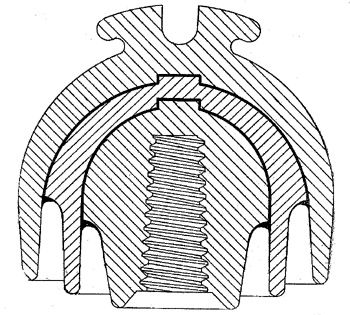[Trade Journal]
Publication: The Electrical Engineer
New York, NY, United States
vol. 25, no. 516, p. 330, col. 2
The Boch High Potential Petticoat Insulator
A HIGHLY efficient insulator adapted for use on electric lines for the transmission of energy with currents of high voltage has recently been placed on the market by the R. Thomas & Sons Company. It is the invention of Mr. John W. Boch, and is illustrated in section below. It is built up of two or more separately molded parts of clay. The inner portion is pressed or molded with a thread for the reception of the usual pin, and the outer portion, shaped like an inverted bowl, is provided with a cross notch on the top for holding the conductor in place, and has side shoulders by which the conductor may be wired down.
 |
| Boch's Glaze-Filled High Potential Petticoat Insulator. |
The process of manufacture of the insulator is as follows: The separately molded parts, after coming from the press, are first dried out separately in an oven or kiln by the process known as "biscuit firing". When they have been thoroughly dried and are ready to be put into the vitrifying kiln they are each coated with a glazing material by dipping the portions into the liquid material. The parts are then fitted into each other and are stood upside down. Glazing material is then put into the joints, that is, the annular channels between the petticoats. The portions are then put into a sagger with the petticoats uppermost and placed in a kiln, in which, under great heat, the clay shrinks and become vitrified, and the glazing material melts and becomes of a glass-like character, adding enormously to the insulation qualities. The glaze which was put into the annular channels flows into and fills all the spaces between the parts of the insulator, that is, such spaces occurring there by lack of correct fit of the parts or arising during the shrinkage by the vitrification of the clay. The extra glazing between the petticoats or at the joints prevents the formation of air spaces or cracks for the entrance of moisture. Every insulator, before it is shipped from the factory, is tested to 60,000 volts by using a specially constructed Westinghouse generator.
